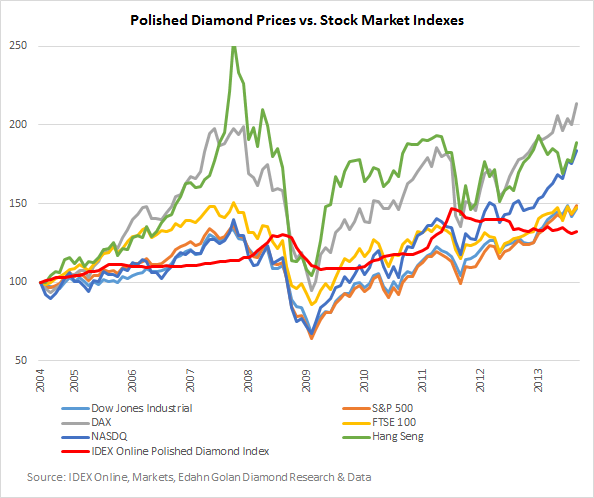The current low polished diamond prices, a result of low demand among other reasons, is cause for concern for many in the market. All want to know when the current hardship will take a turn for the better and prices start to increase, or, in other words, when demand will allow price increases and a (possible) restoration of margins. Judging from the past, the gloom is not completely unfounded, but there is also good reason for hope.When compared to other economic indicators, we tend to say that diamonds are an uncorrelated commodity. This means that the variance in the price of polished diamonds is not related to fluctuations of many economic indicators, such as stock exchange indexes, or other commodities.
From an investment standpoint, this is of course an advantage – while one investment channel is in a downwards trend, another is possibly rising, providing investors with a hedge. However, uncorrelated does not mean that diamond prices are independent, rising and declining completely independent of macro-economic environments.
Serving mainly as an adornment, diamond jewelry is a non-essential product. No one will prefer diamonds to food, shelter or health. Only when the essentials are satisfied and consumers have discretionary funds will they allow themselves extra expenses. That requires economic comfort – be it an income that covers the essentials and beyond, confidence that this income level will be maintained or a sudden improvement– a salary raise, maturing savings or any other additional income.
One such source of additional income is from investments in the stock exchange. Naturally, as long as your stock portfolio is doing well, you don’t tend to sell shares except for refreshing your portfolio a little, replacing slow performing shares with better ones.
The past
When stock markets are rising, polished diamond prices do not show any consistent trend up or down. However, when the markets are declining, polished diamond prices tend to rise in a delayed response. In mid- to late 2007, the major stock exchanges declined sharply. The NASDAQ, Dow, S&P 500, FTSE, DAX, Hang Seng indexes turned south, and did so fast and deep. Starting in early 2008, while these indexes continued to decline, polished diamond prices ran in the opposite direction and hit record-high prices.

A couple of years later, in mid-2010, S&P 500, the Shanghai composite index, FTSE and others dipped, and shortly afterwards polished diamond prices escalated. True, other factors were at play in driving polished diamond price increases (surging demand from retailers in China and India, for example), however when examined long-term, we see this trend repeating itself time after time.
As long as the stock markets are performing well, and our investments are appreciating, we keep our money in the stock market. However, when the bullish run ends, we cash in. Now we have a feeling of extra economic means – we have a lot more money in our hand than we did when we invested it in the market. With the exception of the small sting of taxes and the small recent loss of value, we have the good feeling of added purchasing power – and spend!
The present
In the past year, the stock markets have appreciated strongly. The FTSE is up nearly 12%, the Dow is just shy of 14%, the S&P 500 gained more than 17% and the NASDAQ composite index climbed more than 20%. Conversely, polished diamond prices in this period lost nearly 2% of their value. And while the stock markets have made solid double-digit gains in the year to date period, diamonds lost on average 1.2%.
Once again we are seeing that despite an increase in the value of their portfolio, consumers are not rushing to spend on diamond jewelry.
The future
The sunny weather of the stock market is seen in the diamond market, but the warm rays are not felt. The diamond market, especially in India, is operating under a thick overcast and heavy, gloomy rain. Nevertheless, the prospect is not negative. The economic markets are always cyclical. None of us wants to see the value of our portfolio shrink, but at some point, something goes wrong, or large traders start to place their bets in the opposite direction. When they do that, it just needs to pass critical mass and it becomes a self-fulfilling prophecy. That’s when we realize our holdings – and start spending.
Not a crystal ball, but a forecast based on past occurrences. When the stock market becomes bearish, it’s reasonable to expect demand for diamond jewelry to rise.
